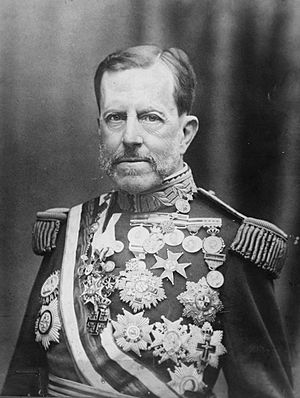Valeriano Weyler facts for kids
Quick facts for kids
Valeriano Weyler
|
|||||||||||||||||||||||||
|---|---|---|---|---|---|---|---|---|---|---|---|---|---|---|---|---|---|---|---|---|---|---|---|---|---|
 |
|||||||||||||||||||||||||
| Governor-General of Cuba | |||||||||||||||||||||||||
| In office 17 January 1896 – 31 October 1897 |
|||||||||||||||||||||||||
| Monarch | Alfonso XIII | ||||||||||||||||||||||||
| Preceded by | Sabas Marín y González | ||||||||||||||||||||||||
| Succeeded by | Ramón Blanco y Erenas | ||||||||||||||||||||||||
| Governor-General of the Philippines | |||||||||||||||||||||||||
| In office 5 June 1888 – 17 November 1891 |
|||||||||||||||||||||||||
| Monarch | Alfonso XIII | ||||||||||||||||||||||||
| Preceded by | Emilio Terrero y Perinat | ||||||||||||||||||||||||
| Succeeded by | Eulogio Despujol y Dusay | ||||||||||||||||||||||||
|
|||||||||||||||||||||||||
| Personal details | |||||||||||||||||||||||||
| Born |
Valeriano Weyler y Nicolau
17 September 1838 Palma de Mallorca, Balearic Islands, Spain |
||||||||||||||||||||||||
| Died | 20 October 1930 (aged 92) Madrid, Community of Madrid, Spain |
||||||||||||||||||||||||
| Political party | Liberal Party | ||||||||||||||||||||||||
| Military service | |||||||||||||||||||||||||
| Allegiance | |||||||||||||||||||||||||
| Branch | |||||||||||||||||||||||||
| Rank | |||||||||||||||||||||||||
| Commands | 6th Army Corps | ||||||||||||||||||||||||
| Wars | |||||||||||||||||||||||||
Valeriano Weyler y Nicolau (1838–1930) was an important Spanish general and leader. He was known for serving as the top governor in both the Philippines and Cuba. Later, he also became the Spanish Minister for War. He was given special titles like the 1st Duke of Rubí and the 1st Marquess of Tenerife.
Contents
Early Life and Military Career
Valeriano Weyler was born in 1838 in Palma de Mallorca, Spain. His family had a history of serving in the Spanish army. His father was a military doctor, which influenced Valeriano to join the army too.
He finished school at the Infantry School of Toledo when he was 16. By age 20, he was a lieutenant. In 1861, he became a captain. He was sent to Cuba in 1863 and earned an award for his actions there. He fought in the Ten Years' War (1868–1878) and later in the Third Carlist War in Spain. By 1878, he had become a general.
Leading in the Philippines
From 1878 to 1883, Weyler was a top military leader in the Canary Islands. In 1888, he became the Governor-General of the Philippines. During his time there, he made an important decision.
He allowed 20 young women in Malolos to attend night school. These women became known as the "Women of Malolos." Their request for education was first turned down by a local priest. He believed women should stay home. However, Weyler visited Malolos and saw how determined the women were. He then approved their request. The Filipino national hero, José Rizal, even wrote a letter praising these women for their efforts.
In 1895, Weyler received a high honor for his leadership in the Philippines. He led troops against an uprising and fought against groups in Mindanao.
Return to Spain and New Roles
After returning to Spain in 1892, Weyler was put in charge of the 6th Army Corps. He helped calm down unrest in the Basque Provinces and Navarre. Later, he became the captain-general in Barcelona until 1896. There, he worked to control groups causing trouble.
He also served as the Minister of War three different times. These terms were in 1901–1902, 1905, and 1906–1907. He was also the Chief of Staff of the Army twice.
Time in Cuba
After another general failed to stop the Cuban Rebellion, Weyler was sent to Cuba in 1896. He was made Governor-General of Cuba with a lot of power. His main goal was to end the rebellion and help Cuba's sugar production recover.
His "Reconcentration" Policy
Weyler faced a difficult situation in Cuba. The Cuban rebels used hit-and-run tactics. They blended in with regular people and lived off the land. Spanish troops, on the other hand, needed many supplies.
Weyler decided he needed to separate the rebels from the ordinary people. He forced over 300,000 men, women, and children to move into areas near cities. These areas were protected by Spanish troops. By doing this, he aimed to make it harder for rebels to get support from the countryside. He also had crops burned and livestock moved away.
This policy, called reconcentrado, made it easier for his army to fight. However, it caused terrible hardship for the Cuban people. Many people were separated from their homes and farms. They were crowded together in tropical conditions with little food. Many suffered from hunger and sickness. It is estimated that between 150,000 and 400,000 people died.
American newspapers reported on the suffering, and Weyler became known as "The Butcher." This negative news helped create strong feelings in the United States against Spain. This was a factor leading to the Spanish–American War in 1898.
Similar policies of moving civilians were used by other countries later on. The term reconcentrado is thought to have led to the term "concentration camp."
Weyler's strategy made many Cubans turn completely against Spain. It also made people around the world upset with Spain. In 1897, the Spanish Prime Minister was assassinated. A new government took over and called Weyler back from Cuba. He was replaced by a general who favored a more peaceful approach.
Later Life and Legacy
After his time in Cuba, Weyler continued to be an important figure in Spain. He was known as a strong and ambitious soldier. In 1900, he was appointed captain-general of Madrid. He successfully defended the government's order during a time of unrest. In 1909, he helped calm disturbances in Barcelona without violence.
Valeriano Weyler was given the title Duke of Rubí and Grandee of Spain in 1920. He was even put in prison for opposing a military dictator in the 1920s. He died in Madrid on October 20, 1930. He was buried simply, as he had wished.
See also
 In Spanish: Valeriano Weyler para niños
In Spanish: Valeriano Weyler para niños

